
Harrison is a village in Sioux County, Nebraska, United States. The population was 239 at the 2020 census. It is the county seat of Sioux County.
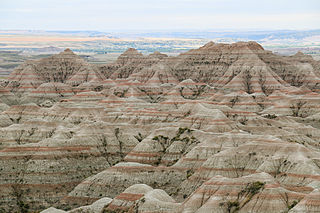
Badlands National Park is an American national park located in southwestern South Dakota. The park protects 242,756 acres of sharply eroded buttes and pinnacles, along with the largest undisturbed mixed grass prairie in the United States. The National Park Service manages the park, with the South Unit being co-managed with the Oglala Lakota tribe.
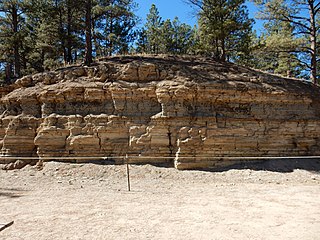
The Florissant Formation is a sedimentary geologic formation outcropping around Florissant, Teller County, Colorado. The formation is noted for the abundant and exceptionally preserved insect and plant fossils that are found in the mudstones and shales. Based on argon radiometric dating, the formation is Eocene in age and has been interpreted as a lake environment. The fossils have been preserved because of the interaction of the volcanic ash from the nearby Thirtynine Mile volcanic field with diatoms in the lake, causing a diatom bloom. As the diatoms fell to the bottom of the lake, any plants or animals that had recently died were preserved by the diatom falls. Fine layers of clays and muds interspersed with layers of ash form "paper shales" holding beautifully-preserved fossils. The Florissant Fossil Beds National Monument is a national monument established to preserve and study the geology and history of the area.
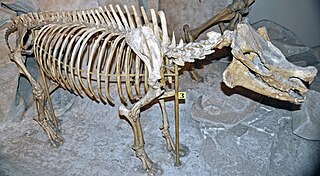
Menoceras is a genus of extinct, small rhinocerotids endemic to most of southern North America and ranged as far south as Panama during the early Miocene epoch. It lived from around 30.7—19.7 Ma, existing for approximately 11 million years.

John Day Fossil Beds National Monument is a U.S. national monument in Wheeler and Grant counties in east-central Oregon. Located within the John Day River basin and managed by the National Park Service, the park is known for its well-preserved layers of fossil plants and mammals that lived in the region between the late Eocene, about 45 million years ago, and the late Miocene, about 5 million years ago. The monument consists of three geographically separate units: Sheep Rock, Painted Hills, and Clarno.

Moropus is an extinct genus of large perissodactyl mammal in the chalicothere family. They were endemic to North America during the Miocene from ~20.4–13.6 Mya, existing for approximately 6.8 million years. Moropus belonged to the schizotheriine subfamily of chalicotheres, and has the best fossil record of any member of this group; numbers of individuals, including complete skeletons, have been found.

Fossil Butte National Monument is a United States National Monument managed by the National Park Service, located 15 miles (24 km) west of Kemmerer, Wyoming, United States. It centers on an assemblage of Eocene Epoch animal and plant fossils associated with Fossil Lake—the smallest lake of the three great lakes which were then present in what are now Wyoming, Utah, and Colorado. The other two lakes were Lake Gosiute and Lake Uinta. Fossil Butte National Monument was established as a national monument on October 23, 1972.

The Ashfall Fossil Beds of Antelope County in northeastern Nebraska are rare fossil sites of the type called lagerstätten that, due to extraordinary local conditions, capture an ecological "snapshot" in time of a range of well-preserved fossilized organisms. Ash from a Yellowstone hotspot eruption 10-12 million years ago created these fossilized bone beds. The ash depth was up to 1 foot.
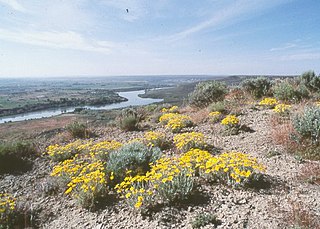
Hagerman Fossil Beds National Monument is a Pliocene-age site near Hagerman, Idaho. The 4,351-acre (17.61 km2) Monument is internationally significant because it protects one of the richest known fossil deposits from the Blancan North American Land Mammal Age. These fossils date from 3.07 million to at least 4 million years ago in age and represent at least 200 species. Hagerman is best known for having the largest known concentration of the fossil horse, Equus simplicidens. The fossil beds, including the historic Smithsonian Horse Quarry, were designated a National Natural Landmark in 1975 and was reclassified as a National Monument in 1988.

Merycoidodontoidea, previously known as "oreodonts" or "ruminating hogs," are an extinct superfamily of prehistoric cud-chewing artiodactyls with short faces and fang-like canine teeth. As their name implies, some of the better known forms were generally hog-like, and the group has traditionally been placed within the Suina, though some recent work suggests they may have been more closely related to camels. "Oreodont" means "mountain teeth," referring to the appearance of the molars. Most oreodonts were sheep-sized, though some genera grew to the size of cattle. They were heavy-bodied, with short four-toed hooves and comparatively long tails.

Daeodon is an extinct genus of entelodont even-toed ungulates that inhabited North America about 23 to 20 million years ago during the latest Oligocene and earliest Miocene. The type species is Daeodon shoshonensis, described by a very questionable holotype by Cope. Some authors synonymize it with Dinohyus hollandi and several other species, but due to the lack of diagnostic material, this is questionable at best.
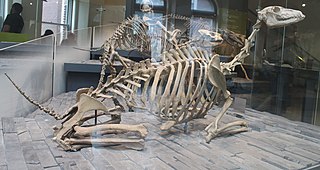
Poebrotherium is an extinct genus of camelid, endemic to North America. They lived from the Eocene to Miocene epochs, 46.3—13.6 mya, existing for approximately 32 million years.

Mesoreodon is an extinct genus of terrestrial herbivore of the family Merycoidodontidae, subfamily Merycoidodontinae, endemic to North America during the Whitneyan stage of the Oligocene-Miocene epochs existing for approximately 12.4 million years.

Merychyus is an extinct genus of oreodont of the family Merycoidodontidae, endemic to North America. It lived during the Miocene, 20.4—10.3 mya, existing for approximately 10 million years. Fossils are widespread through the central and western United States.

Aphelops is an extinct genus of hornless rhinocerotids endemic to North America. It lived from the Middle Miocene to the early Pliocene, during which it was a common component of North American mammalian faunas along with Teleoceras.

Paleontology in Nebraska refers to paleontological research occurring within or conducted by people from the U.S. state of Nebraska. Nebraska is world-famous as a source of fossils. During the early Paleozoic, Nebraska was covered by a shallow sea that was probably home to creatures like brachiopods, corals, and trilobites. During the Carboniferous, a swampy system of river deltas expanded westward across the state. During the Permian period, the state continued to be mostly dry land. The Triassic and Jurassic are missing from the local rock record, but evidence suggests that during the Cretaceous the state was covered by the Western Interior Seaway, where ammonites, fish, sea turtles, and plesiosaurs swam. The coasts of this sea were home to flowers and dinosaurs. During the early Cenozoic, the sea withdrew and the state was home to mammals like camels and rhinoceros. Ice Age Nebraska was subject to glacial activity and home to creatures like the giant bear Arctodus, horses, mammoths, mastodon, shovel-tusked proboscideans, and Saber-toothed cats. Local Native Americans devised mythical explanations for fossils like attributing them to water monsters killed by their enemies, the thunderbirds. After formally trained scientists began investigating local fossils, major finds like the Agate Springs mammal bone beds occurred. The Pleistocene mammoths Mammuthus primigenius, Mammuthus columbi, and Mammuthus imperator are the Nebraska state fossils.

The Ogallala Formation is a Miocene to early Pliocene geologic formation in the central High Plains of the western United States and the location of the Ogallala Aquifer. In Nebraska and South Dakota it is also classified as the Ogallala Group. Notably, it records the North American Land Mammal Ages (NALMAs) Hemphillian, Clarendonian, and Barstovian. It also includes an excellent record of grass seeds and other plant seeds, which can be used for biostratigraphic dating within the formation. The Ogallala Formation outcrops of Lake Meredith National Recreation Area preserve fish fossils. Similar specimens from the same unit are found at Alibates Flint Quarries National Monument in Texas.

This is a list of the National Register of Historic Places listings in Sioux County, Nebraska. It is intended to be a complete list of the properties and districts on the National Register of Historic Places in Sioux County, Nebraska, United States. The locations of National Register properties and districts for which the latitude and longitude coordinates are included below, may be seen in an online map.
Agate is in Sioux County, Nebraska, United States. Agate is located on Nebraska Highway 29, 19 miles (31 km) south-southeast of Harrison. It is home to Agate Fossil Beds National Monument.
Delotrochanter is an extinct genus of large-sized carnivoran mammals, belonging to the Amphicyonidae, that lived in the Great Plains of North America during the Oligocene to Early Miocene. This genus includes some of the largest and last surviving members of the subfamily Temnocyoninae. it furthermore possesses adaptions towards both bone-crushing and cursoriality.




























